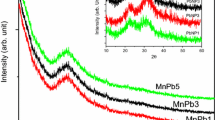Abstract
ZnO–B2O3–P2O5–R n O m glasses containing different concentrations of Fe2O3 (ranging from 0 to 5 mol %) were prepared. A number of studies viz., glass transition temperature (T g ), density (α), thermal expansion coefficient (a), chemical durability, infrared spectroscopic and X-ray diffraction (XRD) patterns of these glasses had been carried out. The results of these studies have been analyzed in the light of different oxidation states of iron ions. The physical properties coupled with infrared spectroscopic and XRD indicates that the iron ions (when present in the concentration range, 0–2 mol %) exist mostly in trivalent state and occupy both tetrahedral and octahedral substitutional positions and are found to increase the rigidity of the glass network. However, in the concentration range of 2–5 mol %, the iron ions in the glass network seem to be existing by and large in Fe2+ state, occupying predominantly octahedral positions and are acting as modifiers.
Similar content being viewed by others
References
Baskaran, G.S., Mohan, N.K., and Veeraiah, N., Influence of aluminium ions on physical properties of PbO–P2O5–As2O3 glasses, Eur. Phys. J.: Appl. Phys., 2006, vol. 34, pp. 97–106.
Saranti, A., Koutselas, I., and Karakassides, M.A., Bioactive glasses in the system CaO–B2O3–P2O5: Preparation, structural study and in vitro evaluation, J. Non-Cryst. Solids, 2006, vol. 352, pp. 390–398.
Hudgens, J.J., Brow, R.K., Tallant, D.R., and Martin, S.W., Raman spectroscopy study of the structure of lithium and sodium ultraphosphate glasses, J. Non-Cryst. Solids, 1998, vol. 223, nos. 1–2, pp. 21–31.
Brow, R.K. and Tallant, D.R., Structural design of sealing glasses, J. Non-Cryst. Solids, 1997, vol. 222, pp. 396–406.
Zhou, M., Li, K., Shu, D., Sun, B.D., and Wang, J., Corrosion resistance properties of enamels with high B2O3–P2O5 content to molten aluminum, Mater. Sci. Eng., A, 2003, vol. 346, pp. 116–121.
Takebe, H., Baba, Y., and Kuwabara, M., Dissolution behavior of ZnO–P2O5 glasses in water, J. Non-Cryst. Solids, 2006, vol. 352, pp. 3088–3094.
Bergo, P., Pontuschka, W.M., and Prison, J.M., Dielectric properties of P2O5–Na2O–Li2O glasses containing WO3, CoO, or Fe2O3, Solid State Commun., 2007, vol. 141, pp. 545–547.
Moustafa, Y.M. and El-Adawy, A., Structural and physical properties of iron oxychloride phosphate glasses, Phys. Status Solidi, A, 2002, vol. 179, pp. 8393.
Brow, R.K., Tallant, D.R., Myers, S.T., and Phifer, C.C., The short-range structure of zinc polyphosphate glass, J. Non-Cryst. Solids, 1995, vol. 191, pp. 45–55.
Sales, B.C. and Boatner, L.A., Leadiron phosphate glass: A stable storage medium for high-level nuclear waste, Science (Washington, D.C.), 1984, vol. 226, pp. 45–48.
Durga, D.K. and Veeraiah, N., Role of manganese ions on the stability of ZnF2–P2O5–TeO2 glass system by the study of dielectric dispersion and some other physical properties, J. Phys. Chem. Solids, 2003, vol. 64, pp. 133–146.
Subbalakshmi, P. and Veeraiah, N., Study of CaO–WO3–P2O5 glass system by dielectric properties, IR spectra, and differential thermal analysis, J. Non-Cryst. Solids, 2002, vol. 298, pp. 89–98.
Xiangyu, F., Ray, C.S., Marasinghe, G.K., and Day, D.E., Properties of mixed Na2O and K2O iron phosphate glasses, J. Non-Cryst. Solids, 2002, vol. 263–264, pp. 293–298.
Shaim, A., Et-Tabirou, M., Montagne, L., and Palavit, G., Role of bismuth and titanium in Na2O–Bi2O3–TiO2–P2O5 glasses and a model of structural units, Mater. Res. Bull., 2002, vol. 37, pp. 2459–2466.
Marasinghe, G.K., Karabulut, M., Ray, C.S., Day, D.E., Booth, C.H., Allen, P.G., and Shuh, D.K., Redox characteristics and structural properties of iron phosphate glasses: A potential host matrix for vitrifying of high level nuclear waste, Ceram. Trans., 1998, vol. 87, pp. 261–270.
Karabuluta, M., Marasinghe, G.K., Ray, C.S., Day, D.E., Waddill, G.D., Booth, C.H., Allen, P.G., Bucher, J.J., Caulder, D.L., and Shuh, D.K., An investigation of the local iron environment in iron phosphate glasses having different Fe(II) concentrations, J. NonCryst. Solids, 2002, vol. 306, pp. 182–192.
Del Nery, S.M., Pontuschka, W.M., Isotani, S., and Rouse, C.G., Luminescence quenching by iron in barium aluminoborate glasses, Phys. Rev. B.: Condens. Matter, 1994, vol. 49, pp. 3760–3765.
Shafer, E.C., Shafer, M.W., and Roy, R., Silica-structure phases: II. Data on FePO4, FeAsO4, MnPO4, BPO4, AlVO4, and others, Z. Kristallogr., 1956, vol. 108, pp. 263–275.
Author information
Authors and Affiliations
Corresponding author
Additional information
The article is published in the original.
Rights and permissions
About this article
Cite this article
Chen, P., Li, S. & Li, Y. Structure and chemical durability of ZnO–B2O3–P2O5–R n O m glass system with Fe2O3 additive. Glass Phys Chem 41, 467–473 (2015). https://doi.org/10.1134/S1087659615050120
Received:
Published:
Issue Date:
DOI: https://doi.org/10.1134/S1087659615050120



